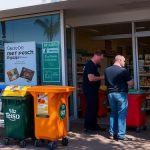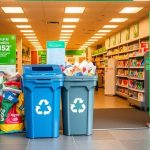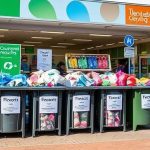What Can You Recycle at a Tesco Recycling Bank?
Tesco’s recycling banks are revolutionising local recycling across the UK. These facilities allow customers to dispose of various materials responsibly. Tesco’s commitment to the environment is clear through this initiative.
Nearly 200 Tesco stores now offer recycling points. Customers can recycle soft plastics like cling film, bread bags, and crisp packets. Pet food pouches are also accepted at these convenient locations.
Tesco’s environmental strategy revolves around their 4R plan: Remove, Reduce, Reuse, and Recycle. This approach has yielded impressive results. The retailer has removed one billion plastic pieces from their operations.
They’ve also reduced packaging by 3,500 tonnes each year. This significant reduction showcases Tesco’s dedication to sustainability.
Currently, 171 locations in South West England and Wales offer new recycling opportunities. These initiatives make recycling more accessible to customers. Tesco is empowering people to join in waste reduction efforts.
Understanding Tesco Recycling Banks and Their Importance
Tesco’s recycling banks are vital for modern waste management. They tackle environmental conservation and community recycling challenges. With 75% of councils facing recycling limitations, these facilities offer crucial services to local communities.
These recycling banks do more than just dispose of waste. They change how communities approach environmental responsibility. They’re reshaping our attitude towards sustainable living.
The Role of Recycling Banks in Waste Management
Recycling banks offer a complete solution to waste management issues. They provide special collection points for materials not usually collected from homes. This includes hard-to-recycle items.
These banks help reduce landfill waste significantly. They also make recycling more accessible to everyone in the community.
- Support for hard-to-recycle materials
- Reduction of landfill waste
- Increased recycling accessibility
Environmental Impact and Sustainability Goals
The environmental impact of these recycling banks is huge. They enable efficient sorting and recycling of materials. This helps reduce greenhouse gas emissions and conserve natural resources.
| Recycling Metric | Environmental Benefit |
|---|---|
| Glass Recycling | 99.9% household accessibility |
| Plastic Bottle Capacity | 900 bottles per recycling unit |
| Compaction Efficiency | 14:1 ratio for larger machines |
24/7 Accessibility for Local Communities
Tesco’s recycling banks are always available. Open 24 hours a day, seven days a week, they make recycling easy for everyone. This includes pedestrians, shoppers, and local residents.
The constant availability could increase community participation in environmental efforts. It makes recycling a convenient part of daily life.
“Recycling is not just about waste management; it’s about creating a sustainable future for our communities.” – Environmental Sustainability Expert
Different Types of Recycling Banks at Tesco
Tesco’s recycling containers offer a handy solution for eco-friendly shoppers. These bins are placed at various spots in Cuffley, Welwyn, and Hatfield. They make it easy to dispose of different materials.
Knowing about these containers helps people manage waste better. It also aids in sustainability efforts.
Blue Banks for Paper Recycling
Tesco’s blue recycling banks are for paper items. They accept a range of materials.
- Newspapers
- Magazines
- Catalogues
- Cardboard
- Junk mail
Red Banks for Multiple Materials
The red recycling containers are more versatile. They handle glass and can recycling.
- Glass bottles and jars
- Food and drink tins
- Aluminium cans
- Plastic bottles
- Beverage cartons
“Proper sorting is key to efficient recycling processes”
Specialised Containers for Specific Items
Tesco also offers bins for other recyclable items. These include:
- Textiles
- Paired shoes
- Belts
- Curtains
- Batteries
Pro tip: Rinse glass containers and crush plastic bottles and cans to maximise recycling bank space.
Acceptable Materials at Tesco Recycling Bank
Tesco recycling banks offer a wide range of recyclable materials collection. These dedicated points provide convenient solutions for responsible disposal. They support local communities in sustainable waste management.
The recyclable materials accepted at Tesco recycling banks include:
- Glass bottles and jars (all colours and sizes)
- Paper and cardboard
- Food and drink tins
- Plastic recycling items
- Beverage cartons
- Textile recycling and shoes
- Batteries (in-store collection)
Plastic recycling options are quite extensive at Tesco. Nearly 200 Tesco stores now have recycling points for soft plastics. Shoppers can return seven types of packaging at these points.
These include:
- Cling film
- Bread bags
- Pet food pouches
- Crisp packets
- Salad bags
- Fruit and vegetable packaging
Tesco accepts clean and dry cardboard materials for recycling. Mixed plastic recycling includes yoghurt pots, margarine tubs, and ice cream tubs. Ready-meal trays are also accepted.
“Recycling is not just about disposal, it’s about responsible resource management.” – Tesco Sustainability Team
Note: Plastic bags, plastic film, and bubble wrap are not accepted here. Ensure all items are clean before recycling. Significant contamination can affect the recycling process.
Electronic Waste Recycling Programme
Electronic waste poses a growing environmental challenge. Tesco has launched a comprehensive recycling programme to tackle this issue. Their initiative aims to address the problem of electrical item disposal.
The UK produces over 100,000 tonnes of electrical waste yearly. This creates significant environmental issues. Tesco’s recycling scheme offers a vital service for responsible e-waste management.
WEEE Directive Compliance
Tesco’s programme follows the WEEE Directive for responsible electrical waste disposal. This ensures hazardous materials don’t end up in landfills. It supports environmental protection and sustainable waste management practices.
- Supports environmental protection
- Prevents toxic materials from contaminating ecosystems
- Promotes sustainable waste management practices
Free Take-Back Service for Electrical Items
Customers can recycle various electrical items for free when buying new products. The service covers a wide range of items.
- Selfie sticks
- Memory cards
- Single-use cameras
- Small electronic devices
Processing of Electronic Waste
| Waste Type | Recycling Rate | Environmental Impact |
|---|---|---|
| Vapes | Up to 80% | Potential to power 10,000 electric cars |
| Electrical Waste | 48-60% | Reduces landfill contamination |
“Responsible electronic waste recycling is not just an option—it’s an environmental necessity.”
Recycling electrical items helps create a more sustainable future. It reduces environmental impact and supports circular economy principles. By participating, consumers contribute to a greener world.
Guidelines and Best Practices for Recycling
Recycling requires careful attention to detail and commitment to proper practices. Tesco recycling banks offer essential services for sustainable waste management. Users must follow specific guidelines to ensure effectiveness.
- Always place items directly into designated recycling banks
- Ensure materials are clean and free from food residue
- Remove any non-recyclable components before depositing
- Do not leave items on the ground or outside the bank
“Proper recycling starts with individual responsibility and attention to detail.” – Sustainability Expert
Recent data reveals significant challenges in recycling infrastructure. Only 7% of soft plastics are collected through kerbside recycling. 88% of local authorities lack soft plastic collection.
Tesco recycling banks play a crucial role in waste management. They help address the gaps in local recycling services.
Critical considerations for effective recycling include:
- Check material compatibility before depositing
- Separate different types of recyclable materials
- Avoid contaminating recycling streams
- Use recycling banks during appropriate hours
Understanding these recycling guidelines helps reduce waste and supports environmental sustainability efforts. Proper recycling practices can help reduce the 215 billion new soft plastic items in the UK annually.
Every small action counts in creating a more sustainable future. Your efforts make a difference for our planet.
Reporting Issues and Maintenance
Recycling bank upkeep needs active community involvement. Residents play a crucial role in keeping sites clean and functional. Tesco values this community effort for environmentally effective recycling.
How to Report Problems
Reporting recycling site issues is easy. Customers can choose from several methods when they spot problems.
- Contact local Tesco customer service
- Use the online problem reporting system
- Speak with site management directly
- Email the designated recycling bank maintenance team
Site Maintenance Schedule
Regular upkeep ensures effective recycling facilities. Our data shows significant waste management challenges:
- Flytipping often exceeds collected recycling materials
- Cleansing services are deployed almost daily
- Tonnage of dumped material frequently surpasses recycling bank collections
Emergency Contacts
Quick action is vital for urgent recycling site issues. Keep these emergency contacts handy:
| Contact Type | Details |
|---|---|
| Local Recycling Team | 0800 RECYCLE |
| Tesco Customer Service | 0800 TESCO HELP |
| Environmental Waste Management | Emergency Hotline |
“Community involvement is key to maintaining clean and efficient recycling facilities.”
Prompt reporting helps Tesco improve recycling bank maintenance. It allows us to tackle recurring issues efficiently.
Conclusion
Tesco’s recycling banks are vital for environmental stewardship. They offer easy access to recycling facilities across 3,500 UK stores. This allows communities to take part in sustainable waste management.
Community responsibility is key to Tesco’s recycling initiative. The retailer shows a global approach to sustainability across 12 countries. People can make a big impact by using these banks correctly.
Tesco’s programme offers a practical solution for eco-conscious consumers. These banks turn waste into valuable resources. This protects our environment and supports a circular economy.
Every small action helps create a greener future. By using recycling banks, we all contribute to a more sustainable world. Together, we can make a significant difference in reducing our ecological footprint.
FAQ
What types of materials can I recycle at a Tesco recycling bank?
Tesco recycling banks accept various materials, including paper, cardboard, glass, plastic bottles, and metal cans. There are special containers for textiles, shoes, and batteries. Always clean and sort items correctly for efficient recycling.
Are Tesco recycling banks open 24/7?
Yes, most Tesco recycling banks are accessible around the clock. This constant availability makes recycling more convenient for local communities. It helps people build consistent recycling habits.
How do I prepare items for recycling?
Rinse containers and remove labels where possible. Separate different materials and ensure items are clean and dry. Flatten cardboard boxes and remove bottle caps before recycling.
What electronic items can I recycle at Tesco?
Tesco offers free take-back for electrical items under the WEEE Directive. This includes small appliances, mobile phones, laptops, and tablets. The service helps keep harmful electronic waste out of landfills.
What should I do if a recycling bank is full?
If a recycling bank is full, contact the local Tesco store or customer service. Try nearby recycling points or come back later. Reporting full banks helps maintain efficient recycling facilities.
Can I recycle textiles and shoes at Tesco recycling banks?
Yes, Tesco has special containers for textiles and shoes. These items should be clean, dry, and in good condition. Pair shoes together and ensure clothing is not excessively worn or damaged.
How does Tesco support environmental sustainability through recycling?
Tesco’s recycling efforts reduce waste in landfills and conserve natural resources. They also help minimise greenhouse gas emissions. By offering accessible recycling, Tesco encourages customers to adopt eco-friendly practices.
How can I report an issue with a Tesco recycling bank?
To report issues, contact your local Tesco store or customer service. Provide details like location and the type of problem. Quick reporting helps maintain effective recycling facilities.















